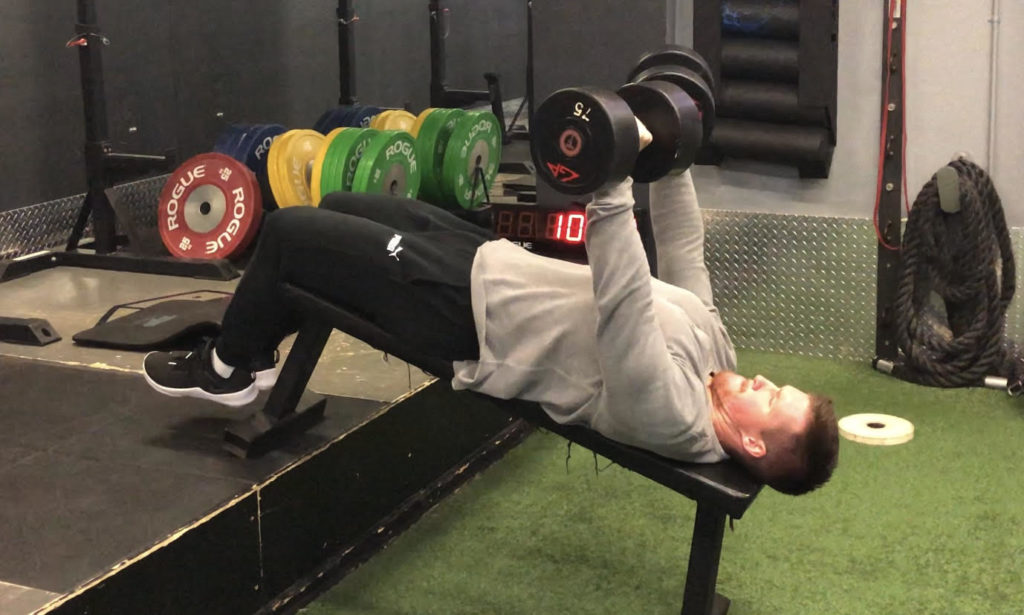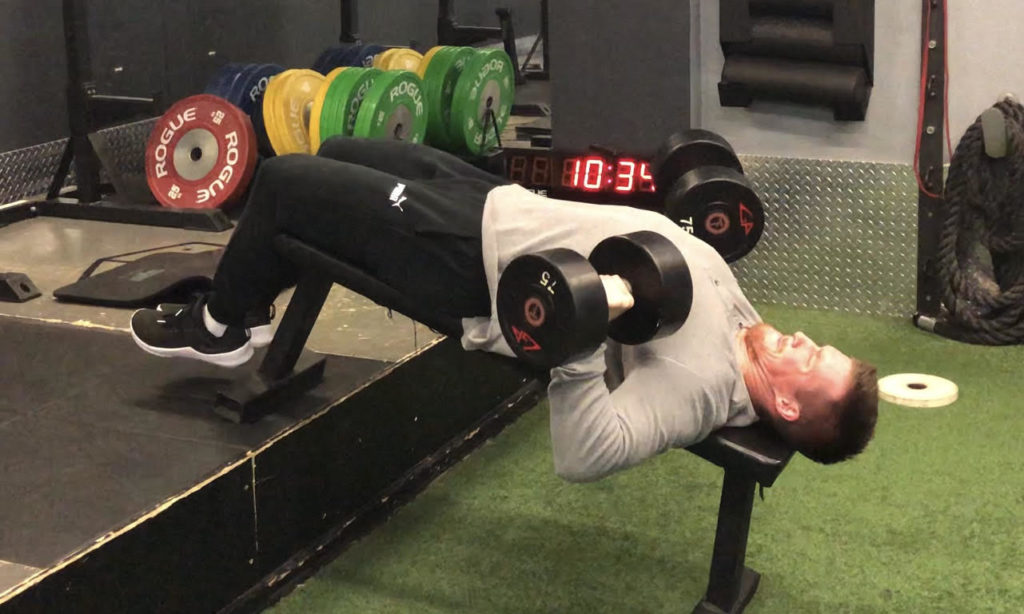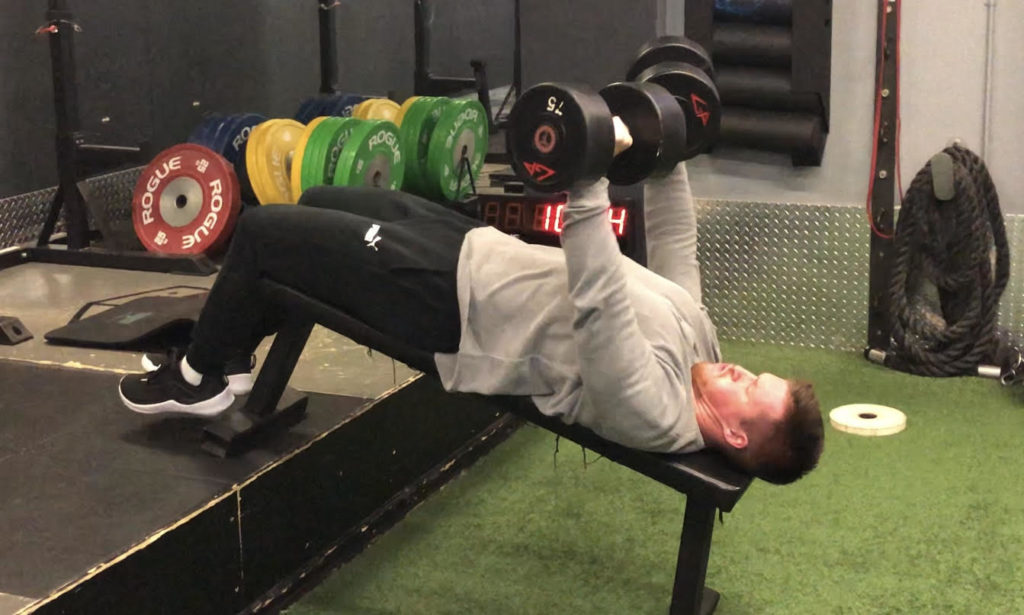The decline bench press is a pressing exercise that may or may not find its way into your training routine. Bench press variations like the flat and incline bench press both are highly beneficial for overall chest development and pressing strength, however little is discussed about the decline bench press variation.
To help coaches and athletes better understand the benefits (and potential limitations) of the decline bench press, we developed this decline bench press ultimate exercise guide that will cover:
- Decline Bench Press Form and Technique
- Benefits of the Decline Bench Press
- Muscles Worked by the Decline Bench Press
- Who Should Do the Decline Bench Press?
- Decline Bench Press Sets, Reps, and Programming Recommendations
- Decline Bench Press Variations and Alternatives
- and more…
Before we dive into this decline bench press guide, it is important to note that this exercise could result in one or some of the following, and caution should be used. Due to the decline bench position, lifters may or may not become more easily lightheaded upon returning to upright, as the blood circulation may be impacted due to gravity. Additionally, caution should be used when racking and unracking weights, as well as getting into position (such as with dumbbells), as this exercise can result in injury if caution and/or spotters are not used. Like most resistance training, be sure to get medical clearance from your doctor and/or trained health professional prior to starting a training program.
How to Do a Decline Bench Press
Below is a step-by-step guide on how to properly set up and perform the decline bench press, more specifically the dumbbell decline bench press. Note, that this exercise can also be done with a barbell. In this set up below the feet are not secured, as there was not access to a proper decline bench. It is for this reason a barbell was not used. Additionally, please note that if you do not have access to a proper decline bench press, you should proceed with caution if you are to use the non-foot secured set up (in the pictures below). That said, the execution of the lift is identical with and without the feet secured.

Step 1: Start by assuming a supine position on a decline bench, ideally with the feet secured properly to avoid sliding off the bench.
You can use this non-foot secured set up with lighter loads if you do not have access to a proper decline bench, but do so with caution.

Step 2: Set your shoulder blades together and keep the chest up, similarly to the back tension in the flat and incline bench press.
Note that the angle will have the barbell above the sternum rather than over your shoulders at the top.

Step 3: While keeping back tension, allow the shoulder and elbow joints to bend as you descend into the bottom of the bench press, with the elbows positioned under the weights.
You can vary the amount of wrist pronation and supination based on preference.

Step 4: Once you have assumed a deep and stretched position in the bottom of the decline bench press, press the weight back up to the locked out position, and repeat.
You should feel the muscles of the lower chest being used. If you are feeling excessive shoulder/anterior shoulder discomfort/muscle fatigue, reassess your setup and elbow positions.
3 Benefits of Decline Bench Press
Below are (3) benefits of the decline bench press that coaches and athletes from most strength, power, and fitness sports can expect when implementing decline bench presses into a training regimen. Read our detailed analysis on the decline vs flat vs incline bench press here.
Builds Lower Chest Size
The decline bench press has been shown to target the lower pectoralis muscle fibers greater than the flat and incline bench press, making it a key exercise to bring up a lagging lower chest.
Decreased Strain on Shoulder
High amounts of pressing (often due to poor technique or excessive loading) can create shoulder discomfort and/or injury. For some lifters, the decline bench press can be used to increase loading on the chest muscles while limiting the abilities of the anterior shoulder to get involved in the press, which may help to minimize any unwanted shoulder stress in training.
Stimulate New Muscle Growth (of the Chest)
The decline bench press, when combined with other pressing and dip exercises can help to stimulate new muscle growth and development. Increase loading abilities, training different angles of the press, and targeting slightly different muscle fibers of the chest can all increase muscle growth.
Muscles Worked – Decline Bench Press
The decline bench press is a bench press movement that targets the chest and triceps, however with greater emphasis on various angles and regions of those muscle groups.
Lower Pectoralis Major
The decline bench press has been shown to work primarily the lower regions of the pectoralis major, slightly more than the flat bench press alternative.
Anterior Deltoid
The anterior deltoid is slightly active in most pressing movements. The anterior deltoid, however, is the least active in the decline press when compared to the flat and incline versions, which could be beneficial for lifters looking to minimize shoulder stress.
Triceps
The triceps are responsible for elbow extension, which occurs in the decline bench press. That said, the decline bench press has been shown to produce less triceps activation than other bench pressing movements; such as the incline bench press and/or close grip bench press (see benefits).
Who Should Do the Decline Bench Press?
Below are some reasons why strength, power, and fitness athletes can benefit from performing the decline bench press.
Strength and Power Athletes
While the bench press is sport specific to powerlifting and some strongman sports, the decline variation is an angle that doesn’t match the angle done in competition. That said, training the decline bench press, as opposed to just training the flat bench press, allows a lifter to take advantage of developing the chest muscles from various angles, working with heavier loads, and decreasing potential strain on the shoulders from constant flat and incline benching.
Including the decline bench within strength and hypertrophy cycles can help to kick-start new muscle growth (especially if you have not done decline bench pressing in a while) and can enhance general pressing strength. That said, the decline bench press is not a replacement for the flat bench press if you are looking for direct application to strength sports (powerlifting).
Bodybuilders
The decline bench press is an exercise that develops the lower pectoral muscles, similar to how the incline bench press can be used to increase the upper pectoral muscles. When size, shape, and symmetry is the goal, selecting exercises that expose a muscle to a wide variety of angles can help to increase muscle activation, stimulate new muscle growth, and develop a more well-rounded and balanced chest muscle.
General Fitness and Movement
The decline bench press can be beneficial if someone is looking to increase overall pressing and chest development, as it can help to increase muscle activation in the lower regions of the chest muscles. Additionally, decreased shoulder stress in the decline bench press could make this a good pressing alternative for lifters who would like to bench press however cannot often handle the discomfort of flat and/or incline bench presses. With that said, if you are experiencing pain while bench pressing, be sure to first review your bench pressing technique, and seek clearance from a trained professional.
How to Program the Decline Bench Press
Below are three primary training goals and programming recommendations when utilizing the decline bench press into specific programs. Note, that these are general guidelines, and by no means should be used as the only way to program the decline bench press.
General Strength– Reps and Sets
For general strength building sets, athletes can perform lower repetition ranges for more sets.
- 4-6 sets of 2-5 repetitions, resting 2-3 minutes
Muscle Hypertrophy – Reps and Sets
For increased muscular size and hypertrophy, the below repetitions can be used to increase muscular loading volume.
- 4-6 sets of 6-12 repetitions, resting 60-90 seconds between, with heavy to moderate loads
Muscle Endurance – Reps and Sets
Some lifters may want to train greater muscle endurance (for sport), in which higher repetition ranges and/or shorter rest periods are recommended.
- 2-3 sets of 12+ repetitions, resting 60-90 seconds between (this is highly sport specific)
Decline Bench Press Variations
Below are two (2) decline bench press variations that can be used by coaches and athletes to keep training varied and progressive. Note, that the decline bench press may be more limited in terms of direct variations when compared with the flat bench press, however the alternatives (next section) are slightly more expensive.
Flat/Floor Bench Press with Hip Bridge
Finding a decline bench can be a difficult task in most functional fitness/CrossFit facilities and home gyms. The flat bench and/or floor press can both be done with a slight hip bridge to vary the angle at which the press is done, matching that of a standard decline bench press (- 15% of a decline). This can be helpful for lifters who are lacking in lower pectoralis development yet do not have access to a standard decline bench.
Decline Dumbbell Bench Press
The decline bench press can be done with dumbbells to increase unilateral development of the lower pectorals and enhance muscle activation (due to increase stability demands, angular changes from wrist pronation/supination, and increases range of motion). This variation can be slightly more difficult to get in and out off, which is why a spotter is recommended (even more so than the decline barbell bench press).
Decline Bench Press Alternatives
Below are three (3) decline bench press alternatives coaches and athletes can use to isolate the lower pectoral muscles without the performing the decline bench press.
Cable Crossovers
Cable crossovers can be done at a wide variety of angles. To work the lower regions of the pectoralis muscles, you would want to set the handles from the low position, crossing them over on an upwards angle (so that they hands move from low to high). Cables can increase time under tension and allow for slightly greater individualization of angles to fit the needs and comfort of the lifter.
Gironda Dips
This dip variation was named after the late Vince Gironda, a professional bodybuilder and trainer, in the 1940-60s, mostly well known for his large slabs of chest muscles (in which he often was against using flat bench presses for optimal chest development), and the quote, “Bodybuilding is 85% nutrition.”
The Gironda dip is done in a very strict manner, with the goal being to keep the elbows out to the sides and the hands wide, either using a set of parallel or V-shaped dip bars. The goal was to isolate the lower pectorals by performing this moment in a deep and controlled movement pattern.
Decline Dumbbell Flye
The decline dumbbell flye is a flye variation that has the lifter perform the movement on a slight decline, which activates the lower pectoralis muscles slightly more than the flat and incline versions. Additionally, this exercise may decrease strain on the shoulders when compared to the incline flye, making it potentially more beneficial if shoulder stress is an issue in the flye (however that could also suggest you are not performing the chest flye correctly).
Decline Push Up
The decline push up is done by placing the hands upon a 2-4 inch platform or plates, matching the typically -15 degree incline of the chest. This is a great way to develop decline pressing capacities before advancing into the decline bench press and/or if you do not have access to a decline bench (however you can look above to see the flat bench press with hip bridge solution).
Featured Image: Mike Dewar